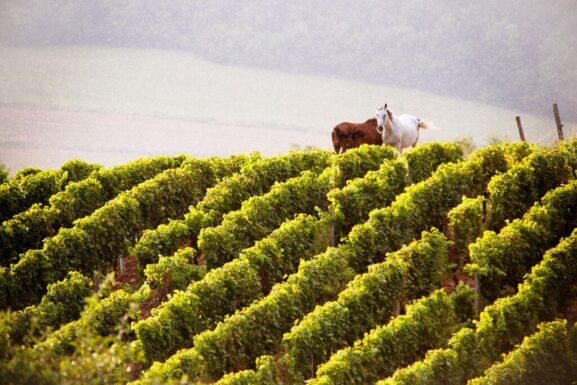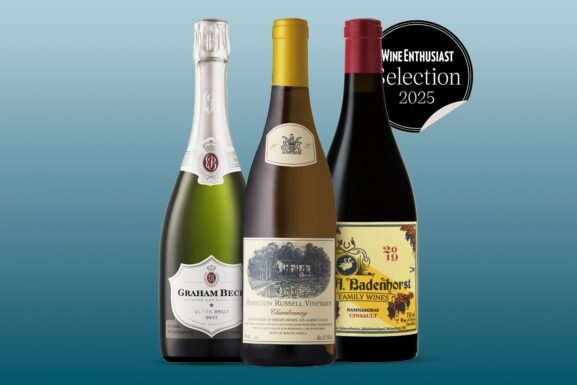Is Double Decanting Worth It?
Though wrapped in an aura of luxury and flashes of fine crystal, the process of decanting wine is really a very basic technique that can enhance the enjoyment of almost every bottle.
That’s something I’ve known for decades, even though I never spend the small bit of time required to do so on the more than 300 bottles I uncork every month in my work for Wine Enthusiast. With decanting earning a lot more attention across social media sites like TikTok and on popular series like The Gentleman in recent years, it felt like the right time to see if I’ve been doing it wrong this whole time.
What Is Double Decanting?
“We decant a lot at the restaurant,” explains Tristan Pitre, the wine director at San Ysidro Ranch in Montecito, California. “People who eat here tend to be drinking the wine right away, and both the whites and red wines benefit from that extra air.”
That goes for older wines from the resort’s more than 12,000 bottles, including verticals of Petrus and Chateau d’Yquem.
“We definitely decant an older wine, but it’s to pull it off the sediment more than anything,” says Pitre. “There are very few things that we are not open to decanting.” (Natural-leaning reds are one category that can get more mousey with more air, for instance.)
Double decanting takes the process up another notch. That’s when the wine is aerated and taken off the sediment by pouring into an initial vessel, then is returned the original bottle, which, at least in restaurants, is usually rinsed of sediment.
While you can use any decanter for this process, there are special products that make it easier, like the Recanter, which attaches to a wine bottle with a drip-proof silicone seal.
“Double decanting for me is about making sure the wine is served in the best way for the guests, letting the wine be able to breathe while keeping the actual bottle presentation intact,” says Travis Padilla, who currently works at Il Buco in Manhattan and double-decants more than 100, mostly larger format wines each year during La Festa de Barolo.
He first learned of decanting from Yannick Benjamin at Contento in East Harlem and Paul Grieco at Terroir in Tribeca. “For me, it’s just another way to be more personal with the guest and build on the story of the wine,” he says.
Pitre agreed, even though he doesn’t often take the extra step of double decanting at San Ysidro Ranch, unless a guest is staying multiple days and picks their wine from the cellar in advance.
“You open up the wine, it gets some air, and then goes back into the bottle and is poured from the bottle,” he said. “Guests like to see that.”
When to Double Decant
During previous jobs in Minneapolis at Demi and Spoon & Sable, Pitre found double decanting critical when serving tasting menus with wine pairings.
“There, you have three ounces per person, and there is not the experience of watching it open up or change,” he says, as compared to letting a wine blossom over time in the bottle or even in just the first decanter. “It needs to be good right away. In those situations, we are double-decanting almost every red wine.”
Padilla also uses double-decanting as a way to introduce a little bit of air but then slow it down, which can be important for older wines that may lose their pleasures with too much air.
“If it’s not for presentation, I tend to focus double decanting on older wines that maybe haven’t gone over the hill yet, but are at the top of the hill with extremely tertiary flavors,” he says. “Putting that in the actual decanter speeds up the aeration a lot more than I personally like. I feel like those wines need slower aeration.” That’s where the more closed confines of the original bottle can help.
As sommelier Amanda McCrossin explained in a recent video for Wine Enthusiast, double decanting can also save time when you’re entertaining at home and plan to serve multiple bottles of wine and only have one decanter. “It’s one of my favorite party hacks,” she commented.

Should You Double Decant (Or Even Hyper Decant)?
Those who watched the popular series Succession are aware that there’s even a more extreme method: putting wine in a blender.
I first experienced this about a decade ago when a good friend of mine in Hollywood threw a young bottle of the acclaimed Bordeaux wine Chateau Pontet-Canet into his blender. I was a bit shocked, but the otherwise very tight wine did open up its aromatics quite a bit.
That friend, Greg Jones, a health care attorney in Los Angeles, learned about the technique from the techie-turned-cookbook author Nathan Myhrvold, who turned his understanding of molecular science into the six-volume Modernist Cuisine: The Art and Science of Cooking.
“He mentioned that he would go into restaurants, order older red wines and ask the somm to put it in a blender,” recalled Jones. “He was usually met with horror.”
Jones and his wife, criminal defense attorney Karen Goldstein, are fans of “big, bold and bad reds,” and thought it might be fun to try.
“We stuck a Bordeaux in the blender one night, thinking we’d do it as a joke,” says Jones. “But when we pulled the top off the blender, the aromas that came out of that thing were just incredible. They were overwhelming. It’s like the nose you get after swirling—but on steroids.”
They started using it on all of their reds that weren’t quite at a mature age. “The gag of it is it’s kinda fun, too,” says Jones, who was surprised to see it on Succession. “I remember thinking, ‘They stole my idea!’”
Technically, these wines wind up being double-decanted in the process. “When you put a nice wine in the blender for decanting purposes, you don’t want to put it in glasses directly,” said Jones. “We end up double decanting because we put it back in the bottle.”
Padilla says that the current trend is to use a milk frother instead. “All types of things go into the blender, which can give it a permanent stench,” he laughs. “Frothers are a cleaner way. Now everyone is using frothers.”
With that in mind, I opened a bottle of Ashes & Diamonds Bates Ranch from 2017, a bit young on the spectrum for Cabernet Sauvignon from the Santa Cruz Mountains. I poured a test glass, gave it a try and then hit the next glass with a frother.
“Look at the head on that!” I exclaimed, as the wine took on a beer-like foam, to which my friend Stacy replied, “Said no one ever!” Despite our doubts, the frother wine was noticeably more fruity and approachable than the original glass.
At home, Pitre said he mostly decants his wines at least once. But his preferred way is a more modern combination.
“One of my favorite ways to have a bottle of wine is to Coravin a glass out of it, and then open the bottle a couple weeks later,” he said. “It has just that right amount of air contact when you open it. It’s perfect right out of the bottle.”
I own a Coravin, and I own multiple decanters, including at least one that’s rigged for easy double decanting. Perhaps it’s about time that I dust them off, and enjoy my wine like these wine pros suggest.
Our Decanting Coverage

From the Shop
A Moment of Zen
Wine Enthusiast’s Art Series Decanters bring sophisticated style to wine decanting and can double as a centerpiece.
Published: June 21, 2024

